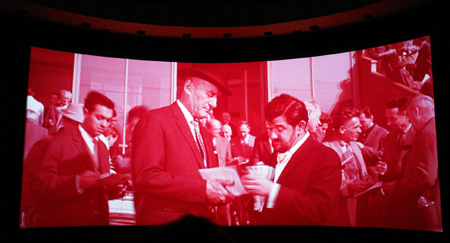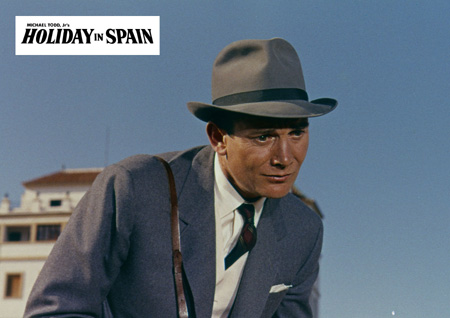Millie Goes to the Golden Head |
Read more
at in70mm.com The 70mm Newsletter |
| Written by: Rick Mitchell, Hollywood, USA. Images by Tom March, Canada. | Date: 23.09.2009 |
|
For those who don't get it, this is a tongue-in-cheek
combination (and a dual setup for The Hideous Pun Demon) of the original
and final release titles of a mid-Sixties European would be roadshow
that finally had its first public screening in the United States on
Sept. 9, 2009! Using the only known existing 70mm print, even if it was
Kenemacolor. The history of how this was made about is a bit murky. It was intended to be the third of four films MGM had contracted to make with Cinerama in its three panel process. And yet, although some dubious projects were being announced as potential roadshows, AIP's proposed "ALI BABA AND THE SEVEN MIRACLES OF THE WORLD" for example, this project was the least likely for success, especially for a roadshow in three panel Cinerama. Hayley Mills had originally been signed to star and assuming the film was written for the older college undergrad teenage Hayley of "IN SEARCH OF THE CASTAWAYS" and "THE MOONSPINNERS", the plot about a British police detective's kids tracking down the thieves who had stolen a national Hungarian treasure was still too thin to justify such a film, at least if its location were limited to Hungary with a cast whose name value was limited to Hayley and Lionel Jeffries. |
More
in 70mm reading: "The Golden Head" Revisited 6. Todd-AO 70mm-Festival 2010 3-Strip at the Dome - and 70mm too! Who is Rick Mitchell? Internet link: Jess Conrad official web site |
 Image
by Tom March. Filmed owned by Cinerama & Pacific Theatres. Image
by Tom March. Filmed owned by Cinerama & Pacific Theatres.Apparently the film was a ploy by the then owner of Cinerama, Inc., Nicholas Resini, to make a big looking movie cheaply in Eastern Europe, something a number of independent producers of big international films, like Samuel Bronston and Dino, were doing at the time, what with production costs rising in the by then overfilmed Italy and Spain. In addition to the cast, the strange original choice of director was James Hill, who, according to Ezra Goodman in The Fifty Year Decline and Fall of Hollywood, was responsible for the breakup of the pioneering Hecht-Lancaster company and aside from briefly marrying Rita Hayworth, had directed one not well received caper film, "THE HAPPY THIEVES". Contrary to what has appeared most notoriously in a certain red book, production in three panel had been abandoned before the original version started shooting, which was after "MAD, MAD WORLD" had inaugurated "single lens Cinerama", and possibly even after the Technirama shot "CIRCUS WORLD" had been shown that way using a 70mm print, which would explain why that format was chosen for what was then known as "MILLIE GOES TO BUDAPEST". Once it had successfully made 70mm prints from a live action Technirama film with "SOLOMON AND SHEBA" in 1959, Technicolor had been pushing that as a cheaper alternative to 65mm origination with the format being used for a number of European period films that were given the roadshow treatment there but were shown in 35mm in the US, and not always from IB prints, "THE LEOPARD" being the most notorious example; it was even advertised as being in CinemaScope! |
|
|
Anyway, MGM didn't like the dailies and cancelled their contract, though it
would later do "GRAND PRIX", "2001", and "ICE STATION
ZEBRA" in Super Panavision and shown as "Cinerama" roadshows. Production
was stopped and Mills and Jeffries also left. The film was apparently
rewritten to make Milly what's known today as a "tween" and George Sanders
and Buddy Hackett brought in as the thieves. (Sanders actually seems to be
enjoying himself in a couple of scenes with Hackett rather than displaying
the usual bored hautre of his later roles.) Hill was replaced by an even
stranger choice, Richard Thorpe. In his seminal B Movies, Don Miller has
high praise for the cheap Bs Thorpe directed before he was signed by MGM,
but after that he became one of the faceless journeymen of the Thalberg-Mayer
period, who mainly just got the coverage on schedule and on or under budget
knowing their work would likely be reshot by another journeyman. Though his
name is on two of MGMs biggest hits of the Fifties, "IVANHOE" and
"KNIGHTS OF THE ROUND TABLE", in my opinion neither is as good as George
Sidney's "THE THREE MUSKETEERS" or "SCARAMOUCHE", made either
when Mayer wasn't holding the reins as tightly or after Schary had brought
the studio into the second half of the 20th Century. And I don't see a real
comedy in Thorpe's filmography; he was apparently Robert Taylor's favorite
director and Taylor and comedy doesn't compute. And that is the retitled "GOLDEN HEAD"'s biggest selling point, a surprisingly witty script, all the more surprising since the credited writers, Stanley Goulder and Ivan Boldizsar, have never been heard of before or sense, suggesting either one or both are pseudonyms or some ghost writing had been done (and not by Rex McGee, George Simpson, or Aubrey Solomon who would have been too young). If an elder statesman journeyman director was desired, a better choice would have George Marshall or Norman Taurog, who had better comedy experience. Of course best of all would have been Frank Tashlin. Or from an even less traditional standpoint, such up-and-coming British based iconoclasts as Richard Lester, Ken Hughes, or Joseph McGrath. Any of them would have definitely done something with the climactic chase, portions of which were shot in 65mm with the German MCS Superpanorama camera and are the only scenes in the film shot with wide angle lenses that have a "Cinerama" effect. (That Technirama's widest lens could be used effectively can be seen in "PARIS HOLIDAY" (1958).) |
|
 Image
by Tom March. Filmed owned by Cinerama & Pacific Theatres. Image
by Tom March. Filmed owned by Cinerama & Pacific Theatres."THE GOLDEN HEAD" is actually not that bad a film. It's in the tradition of films made by various European countries going back to the Twenties aimed at the "tween" audience, usually lighthearted mysteries with kids solving crimes. Disney started making some of these in the Sixties to free up frozen funds, most playing in the US as multiparters on the "The Wonderful World of Color" tv series. Perhaps with a wider European canvas and 80 DAYS like cameos from an international cast, it might have gotten by in the increasingly overstocked roadshow market, especially in Europe. Somewhere in all this, William R. Forman of Pacific Theaters had bought Cinerama, Inc. and he decided not to release the film in the US, though, when Pacific started its own distribution organization, Cinerama Releasing, they actually could have released it to small markets and kiddie matinees. Depending on the transfer costs, it's probably worth a video release, though I wouldn't know about that. |
|
 "Holiday in Spain" 2010 lobby card by Schauburg Archive "Holiday in Spain" 2010 lobby card by Schauburg ArchiveAs noted in the introduction, the 70mm print of "THE GOLDEN HEAD" shown at the Cinerama Dome was faded, but like most prints from the early Sixties, not as badly as those who psychotically abhor any even slightly faded prints, such as the party for whom my synonym for such prints is named, like to claim. Knowing about the prints in advance, the audience seemed to have no problem with it or the companion feature "HOLIDAY IN SPAIN", which I discussed in a previous spamming, and heartily applauded both films at the end. This suggests that the increased hesitance of American distributors and some programmers to show less than perfect prints is misplaced, if they're all that's available on a title and this is made clear to the audience. For years now, less than perfect prints, particularly of 70mm or Cinerama films, have been regularly shown at European venues such as the Pictureville Cinema in Bradford, England, whose audiences appreciate the opportunity the opportunity to see works which can't be reprinted due either to cost or problems with the underlying elements---like they may no longer exist. Hopefully the success of these screenings will allow us to see rare 70mm and Cinerama films also. |
|
|
Go: back
- top - back issues
- news index Updated 22-01-25 |
|
